I was trying to follow "On the Hardware Implementation of Triangle Traversal Algorithms for Graphics Processing" (Royer, Ituero, Lopez-Vallejo, & Barrio) (page 4) to implement Zig-Zag traversal algorithm for triangle triversal/rasterization. However, the explanation in the paper is counter-intuitive for me and I was not able to make it work.
I tried to implement a finite state machine but I can't quite figure out the exact states. For now, I'm having (direction, e_1, e_2, e_3) where e_n represent edge test output for each edge. Pseudo code:
if (right, true, true, true):
x++; // Move towards right
else if (left, true, true, true):
x--; // Move towards left
else:
// This is where I stuck. There should be two cases where in one of them
// y goes down and x doesn't change direction, in the other case x simply
// flips its direction. But I wasn't able to figure it out.
Any help would be appreciated!
Edit: My effort so far: While the edge test is working correctly, only few parts of the graph was rasterized.
/// Zig Zag (not working)
int top_row = floor(fmin(y0, fmin(y1, y2)));
int bot_row = floor(fmax(y0, fmax(y1, y2)));
if (y0 > y1) {
swap(x0, x1); swap(y0, y1);
}
if (y0 > y2) {
swap(x0, x2); swap(y0, y2);
}
if (y1 > y2) {
swap(x1, x2); swap(y1, y2);
}
assert(top_row == floor(y0));
assert(bot_row == floor(y2));
bool direction = true;
bool changed = false;
int x = floor(x0); int y = floor(y0);
while (y <= bot_row) {
bool e1, e2, e3;
e1 = edge_test((float)x+0.5, (float)y+0.5, x0, y0, x1, y1) < 0.0f;
e2 = edge_test((float)x+0.5, (float)y+0.5, x1, y1, x2, y2) < 0.0f;
e3 = edge_test((float)x+0.5, (float)y+0.5, x2, y2, x0, y0) < 0.0f;
if ((e1 == e2) && (e2 == e3)) {
if ( x < 0 || x >= width ) continue;
if ( y < 0 || y >= height ) continue;
samplebuffer[y][x].fill_pixel(color);
if (direction) x++;
else x--;
} else if (changed) {
y++;
changed = false;
} else {
direction = !direction;
changed = true;
if (direction) x++;
else x--;
}
}
